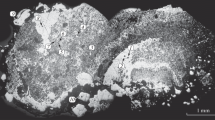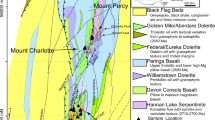Abstract
New sulphur and sulphate-oxygen isotope measurements for the main discordant and stratiform lead-zinc-barite orebodies at Silvermines Co. Tipperary, allow reappraisal of previously offered differing interpretations (Graham, 1970; Greig et al., 1971) of the bearing of sulphur isotopes on the genesis of this important Irish deposit. The following aspects of the data are confirmed: barite δ34 S-values range from 17–21‰, similar to lower Carboniferous seawater sulphate: stratiform sulphide lens pyrites have δ34 S-values ranging from −13 to −36‰; vein sulphide δ34 S-values range from −8 to 4‰; sulphide δ34 S-values increase upwards and outwards respectively in the related discordant and stratiform “G” orebodies; galena-sphalerite isotope palaeotemperatures are not too consistent, ranging from 40 to 430°C (using the calibration of Czamanske and Rye (1974). New facts are as follows: barite δ18O-values range from −13 to −17‰, stratiform barites ranging from 13 to 14.5‰; sulphides separated from a single stratiform ore lens hand specimen usually have δ34 Ssl > δ34 Sga > δ34 Spy; the outward decrease in δ34 S-values in the stratiform “G” orebody is confined to the first few hundred feet only; pyrite δ34 S-values progressively increase downwards through one stratiform sulphide orebody; yet variations of 13‰ occur within a single colloform pyrite structure from another stratiform orebody. It is concluded that there were at least two sources of sulphur, seawater sulphate and deep-seated sulphur. The former was the dominant source of all sulphate and, via biogenic reduction, of the sulphur in the bulk of the stratiform sulphide. The latter was the source of the sulphur in the vein sulphides. There was minimal isotopic interaction between the cool seawater sulphate and the warm unwelling ore fluid sulphur species, even though the latter precipitated under near isotopic equilibrium conditions when the temperature dropped and/or the pH and Eh increased. The lack of isotopic equilibrium between pyrite and ore sulphides in the stratiform ore lenses may result from the latter having precipitated slightly later than the former because of solubility relationships. Overall the present isotopic evidence supports considerable geological evidence favoring a syngenetic origin for the stratiform Silvermines orebodies.
Similar content being viewed by others
References
Barrett, J.: Unpubl. Ph. D. Thesis, London Univ.
Czemanske, G. K., Rye, R. O.: Experimentally determined sulfur isotope fractionations between sphalerite and galena in the temperature range 600° to 275°C. Econ. Geol. 69, 17–25 (1974)
Derry, D. R. Clark, G. R. Gillatt, N.: The Northgate base-metal deposit at Tynagh, Co. Galway, Ireland. Econ. Geol. 60, 1218–1237 (1965)
Gardiner, P. R. R.: Depositional patterns and their tectonic controls in the Devonian and Lower Carboniferous of the south of Ireland. Abstr. G. S. A. 1974 Ann. Meetings
Graham, R. A. F.: The Modul base metal deposits, Co. Tipperary, Ireland. Unpubl. Ph. D. Thesis, Univ. Western Ontario (1970)
Greig, J. A., Baadsgaard, H., Cumming, G. L., Folinsbee, R. E., Krouse, H. R., Ohmoto, H., Sasaki, A., Smejkal, N.: Lead and sulphur isotopes of the Irish base metal mines in Carboniferous carbonate host rocks. Soc. Mining Geol. Japan. Spec. Issue 2, 84–92 (1971)
Hartmann, M., Nielsen, H.: δ34 S-Werte in rezenten Meeressedimenten und ihre Deutung am Beispiel einiger Sedimentprofile aus der Westlichen Ostsee. Geol. Rdsch. 58, 621–655 (1969)
Hulston, J. R., Shilton, B. W.: Sulphur isotopic variations in Nature — Part 4: Measurement of sulphur isotopic ratio by mass spectrometry. N. Z. J. Sci. 1, 91–102 (1958)
Kajiwara, Y., Krouse, H. R.: Sulfur isotope partitioning in metallic sulfide systems. Can. J. Earth Sci. 8, 1397–1408 (1971)
Lloyd, R. M.: Oxygen isotope behaviour in the sulfate-water system. J. Geophys. Res. 73, 6099–6110 (1968)
Marowsky, G.: Schwefel-, Kohlenstoff- und Sauerstoff-Isotopenuntersuchungen am Kupferschiefer als Beitrag zur genetischen Deutung. Contrib. Mineral. Petrol. 22, 290–334 (1969)
Morrissey, C. J. Davis, G. R., Steed, G. M.: Mineralization in the Lower Carboniferous of Central Ireland. Trans. Inst. Min. Metall. 80, B174–185 (1971)
Nielsen, H.: Data handling in precise isotope ratio research. In: Advances in Mass Spectrometry, Vol. 4, 267–272 (1968)
Ohmoto, H.: Systematics of sulfur and carbon isotopes in hydrothermal systems. Econ. Geol. 67, 551–578 (1972)
Rafter, T. A.: Oxygen isotopic composition of sulphates - Part 1: A method for the extraction of oxygen and its quantitative conversion to carbon dioxide for isotope radiation measurements. N. Z. J. Sci. 10, 493–510 (1967)
Rhoden, H. N.: Structure and economic mineralization of the Silvermines district, County Tipperary, Eire. Trans. Inst. Min. Metall. 68, 67–94 (1958)
Ricke, W.: Präparation von Schwefeldioxid zur massenspektromischen Bestimmung des Schwefel-Isotopen-Verhältnisses S32/S34 in natürlichen Schwefelverbindungen. Z. analyt. Chem. 109, 401–413 (1964)
Russell, M. J.: Structural controls of base metal mineralization in Ireland in relation to continental drift. Trans. Inst. Min. Metall. 77, B117–128 (1968)
Schultz, R. W.: The Northgate base-metal deposit at Tynagh, County Galway, Ireland. Econ. Geol. 61, 1443–1449 (1966)
Schwarcz, H. P., Burnie, S. W.: Influence of sedimentary environments on sulfur isotope ratios in clastic rocks: a review. Mineral. Deposita 8, 264–277 (1973)
Solomon, M., Rafter, J. A. Dunham, K. C.: Sulphur and oxygen isotope studies in the North Pennines in relation to ore genesis. Trans. Inst. Min. Metall., 80, B259–277 (1971)
Taylor, H. P.: The application of oxygen and hydrogen isotope studies to problems of hydrothermal alteration and ore deposition. Econ. Geol. 69, 843–883 (1974)
Thode, H. G. Monster, J.: Sulfur isotope geochemistry of petroleum, evaporite, and ancient seas. In: Fluids in Subsurface environments, A. Young, J. E. Galley Eds., Symp. Amer. Assoc. Petrol. Geol. 4, 367–377 (1965)
Weber, W. W.: Modern Canadian exploration techniques reveal major base metal occurrence at Silvermines Co. Tipperary, Eire. Can. Min. J. May 54–57 (1964)
Author information
Authors and Affiliations
Rights and permissions
About this article
Cite this article
Coomer, P.G., Robinson, B.W. Sulphur and sulphate-oxygen isotopes and the origin of the silvermines deposits, Ireland. Mineral. Deposita 11, 155–169 (1976). https://doi.org/10.1007/BF00204478
Received:
Issue Date:
DOI: https://doi.org/10.1007/BF00204478




